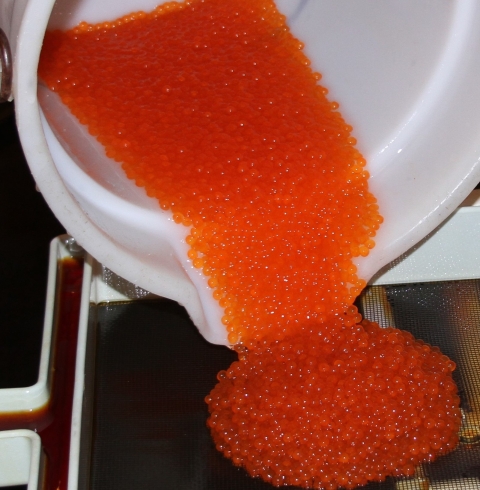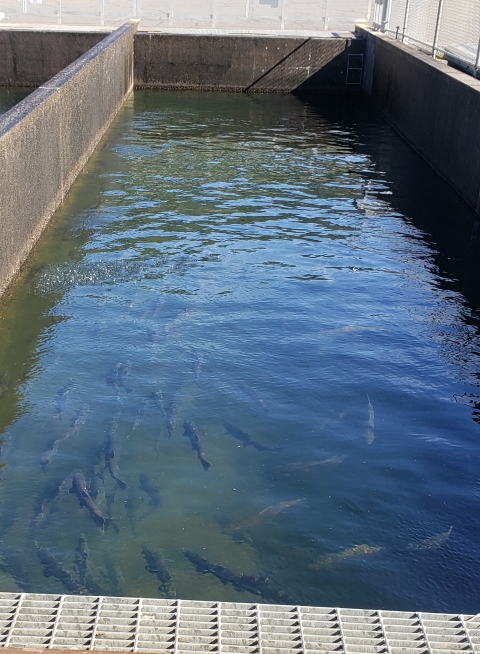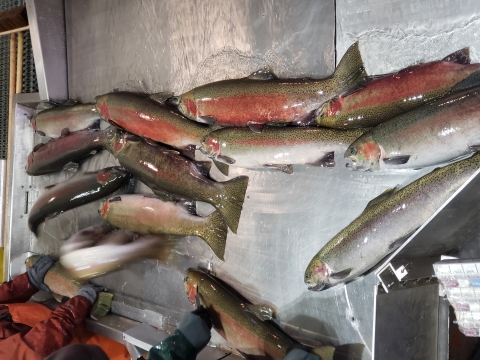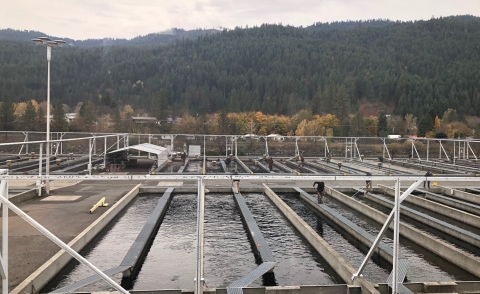What We Do
WHAT WE DO...
Dworshak National Fish Hatchery is the largest combination producer of steelhead trout and Spring Chinook and Coho salmon in the world. The hatchery is located in north-central Idaho at the confluence of the North Fork and the main Clearwater River, just below Dworshak Dam. The hatchery was constructed by the Corps of Engineers because the Dam blocks returning adult steelhead and salmon from reaching their historic spawning grounds on the North Fork-Clearwater River.
The Dam was constructed out of necessity due to continual flooding in the clearwater basin. It is also a power supplier as well as a host for the beautiful 54 mile long, 800 foot deep Dworshak Reservior. Dworshak Dam is also the tallest straight axis dam in the western hemisphere, standing at a majestic 717 feet tall.
Water is heated in the incubation trays and Nursery to gain growth and development for eggs, fry and young fish. In 2010, water was replumbed water from Dworshak Reservoir line which provides warmer rearing water for steelhead after they are moved out of the Nursery. Chinook eggs/fry are incubated on chilled water to slow egg development and growth. These fish are reared on the pumped North Fork Clearwater River water supply. Incubation temps range from ~36.5F to 44F and raceways temperatures range from 41 to as high as 50 F.
Upon reaching 'fry' size (approximately 5 inches in length), the fish are released into the Clearwater river for their trip to the Pacific ocean. After several years in the ocean, growing large on the various types of food available, the famous Clearwater “B” strain of steelhead trout return to the hatchery from the Pacific Ocean from October until May, and are spawned from January through April. Chinook salmon return from May to August, and are spawned from late August to early September. Adult Coho salmon return from October thru late November, with spawning occurring during that time.
Returning adult fish swim up the hatchery fish ladder directly into large holding ponds. These fish are three to five years in age and weigh from 12 to 20 pounds, much less than when they left the ocean several months earlier.
Eggs are collected from ripe adult females and mixed with milt collected from males to complete fertilization.
Fertilized eggs are placed in incubation trays until they reach the ‘eyed’ stage, when black eyespots are visible. The eggs are sorted, counted and moved to special hatching jars in the larger nursery tanks. Steelhead and salmon hatch with yolk sacs attached, which provides their only source of food for the first few weeks of life. Once the yolk sac is absorbed, the young fish are fed a finely powdered fish food several times daily.
The young fish remain in the nursery tanks for several months until they reach the ‘fry’ stage, then are moved to outside rearing ponds. All fish raised at the hatchery receive an identifying mark of some type when they are moved from the nursery building to outside rearing ponds. These young fry are sent through an automated marking trailer where a small fin is clipped or tags are implanted, before they go into the ponds. These marks allow steelhead and Chinook only to be kept during a legal sport fishing season.
Each Spring, as the fish begin to smolt (an internal change preparing them for life in saltwater) half of the fish are released directly from the hatchery rearing ponds into the Clearwater River, and the rest are trucked to upstream tributaries to begin their downstream migration. Coho salmon are acclimated and released from Kooskia National Fish Hatchery upstream on Clear Creek.
To aid the juvenile fish in this journey, eight dams on the lower Snake and Columbia Rivers increase their water releases during the summer months to help push the fish downstream more quickly. Salmon and steelhead can also be collected at the dams and barged or trucked downstream beyond Bonneville, the first dam on the lower Columbia River.
In an ideal year, 6,500 eggs from one female steelhead could produce up to 55 adult fish back to the Clearwater River in three years. For Chinook salmon an average of 3,000 eggs per female will yield approximately 2 adult fish returning to the river in three years. Mature female coho salmon typically produce about 3300 eggs, which can yield between 2-4 adult fish in 3 years.
At Dworshak, we take great pride in raising healthy fish. Our annual fish production includes 2.1 million steelhead trout, 1.65 million spring Chinook smolts, 700,000 spring Chinook parr, and 500,000 Coho Salmon.
Management and Conservation
The Snake River Basin Adjudication
In 2007, Congress enacted a landmark decision that settled a 20-year legal battle over water rights between the Nez Perce Tribe, the state of Idaho, and the U.S. Fish and Wildlife Service. The SRBA defines the rights and responsibilities of all Idaho water users and provides funding for tribal water and fisheries projects. The agreement calls for Tribal co-management of Dworshak National Fish Hatchery and full management of Kooskia NFH. Fish production goals at both hatcheries remain the same. A portion of the settlement provides a Tribal trust fund to protect and restore fish habitat in the Salmon and Clearwater River basins. Part of the agreement allows for multiagency management of annual water releases from Dworshak reservoir to benefit fish passage fish passage
Fish passage is the ability of fish or other aquatic species to move freely throughout their life to find food, reproduce, and complete their natural migration cycles. Millions of barriers to fish passage across the country are fragmenting habitat and leading to species declines. The U.S. Fish and Wildlife Service's National Fish Passage Program is working to reconnect watersheds to benefit both wildlife and people.
Learn more about fish passage and provide for recreational use of the reservoir.
Cultural Connection Steelhead and salmon have played a key role in the cultural past of the native peoples who once lived in or near the Clearwater River basin. That tradition continues to this day. The Nez Perce people, known historically as the “Ni mii Pu,” lived and thrived in this region for ages. The small town of Ahsahka, next to Dworshak National Fish Hatchery, was once the site of the largest inland fishing village for Native Americans throughout the Pacific Northwest. Each season, Tribes would gather here and harvest from the abundant North Fork runs of Chinook and steelhead. They considered the fish to be much more than a food source or trade item. Fish were, and still are, a sacred and significant part of many Tribes’ spiritual and cultural identity. For some, the return of these fish also symbolizes the renewal of life.
Dworshak and Kooskia fish hatcheries have protected Tribal fishing grounds adjacent to each facility. Only Tribal members are allowed to use traditional or modern methods to harvest salmon and steelhead. When fish returns exceed hatchery goals, surplus fish are collected by several different Tribes for ceremonial and cultural purposes. Excess adult fish are often transferred to wilderness streams to supplement natural populations and to provide nutrients after spawning.
Our Services
ALL YEAR...Our work never ends!
January
- The hatchery fish ladder is opened intermittently for B-run steelhead trout. Adult fish are kept in outside holding ponds temporarily until they are spawned. Steelhead smolts are in outside Burrows ponds as they only have a couple months left on the hatchery before they are released to start their 800 mile journey to the ocean.
- Chinook smolts are in the 30 raceways toward the west end of the hatchery and are also in the final stretch of their time here before being released in March to start their downstream journey to the ocean.
- Steelhead spawning begins in January. Spawning occurs intermittently during the month depending on when the fish are ready to be spawned. This varies somewhat from year to year depending on the water temperatures that they have been exposed to over the past few months. Spawning starts at approximately 8am and typically occurs on Tuesdays, and may continue to early afternoon depending on the number of fish that are spawned on that day. Visitors may watch the process from the viewing balcony in the main hatchery building. Volunteers are on hand to answer questions for scheduled tours.
- Year-old steelhead and salmon are PIT-tagged prior to their release in April. Idaho Fish and Wildlife Conservation office conducts river surveys and off-site PIT tag operations on Chinook salmon smolts.
- School and group tours are at their peak in the spring due to weekly steelhead trout spawning.
- The Hatchery is closed to the public on New Year’s Day, but will be open to the public on Martin Luther King, Jr. Day.
February
- Steelhead spawning will occur intermittently during the month of February continues through the end of April. Spawning begins at approximately 8am and typically occurs on Tuesdays and may continue to early afternoon. Visitors may watch the process from the viewing balcony in the main hatchery building. Volunteers are on hand to answer questions for scheduled tours.
- Coho pre-smolts are moved to Kooskia National Fish Hatchery for acclimation and conditioning prior to direct release into Clear Creek.
- Staff from the Pacific Region Fish Health Department begin pre-release health surveys on the steelhead smolts, Chinook smolts and Coho pre-smolts at the hatchery.
- School and group tours are at their peak in the spring which coincides with the peak of steelhead trout spawning.
- The hatchery is open to the public on President's Day.
March
- Steelhead spawning continues each Tuesday, beginning at approximately 8am. Visitors may watch the process from the viewing balcony in the main hatchery building. The majority of the steelhead spawning occurs in March and additional eggs are collected to support our partners with the Idaho Fish and Game as eggs are transferred to the Clearwater State Fish Hatchery located just across the North Fork River and the Magic Valley State Fish Hatchery also receives eggs spawned at Dworshak. Volunteers are on hand to answer questions for scheduled tours.
- Eggs from February spawning dates are beginning to hatch in the nursery.
- Release of 280,000 Coho from the Kooskia National Fish Hatchery into Clear Creek occurs.
- 1,050,000 Spring Chinook Salmon smolts are released directly into the North Fork Clearwater River to start their 800 mile journey to the Pacific Ocean.
- School and group tours are at their peak in the spring due to weekly steelhead trout spawning. Reservations should be made in advance (a couple weeks is preferred).
April
- Steelhead spawning continues intermittently through the end of the month to ensure that the eggs collected represent the later part of the run. Visitors may watch the process from the viewing balcony in the main hatchery building. Volunteers are on hand to answer questions for scheduled tours.
- Steelhead fry are hatching and feeding in the nursery.
- Nearly 2.1 million steelhead smolts are released into the Clearwater River from the hatchery and at off-site release locations to begin their 800 mile journey to the Pacific Ocean.
- Chinook Salmon fry are moved outside into the raceways from either incubation stacks or from nursery rearing tanks.
- Steelhead trout sportfishing season closes this month; The Idaho Department of Fish and Game has up-to-date regulations posted on their site.
May
- The hatchery fish ladder is closed and cleaned out at the completion of steelhead spawning, and all outside ponds are cleaned and disinfected following smolt releases.
- Steelhead fry are hatching and feeding in the nursery.
- The first of the young steelhead spawned back in January are reaching a size where they are beginning to be moved outside from the nursery in May. These fish have their adipose fin removed to identify them as a hatchery reared fish. The fish may also receive a coded wire tag at this time. The tags are valuable in providing information after they are released approximately 1 year later.
- Coho salmon are trucked from Kooskia to Dworshak at 2-3 inches where they will be reared until next February and then returned to Kooskia for acclimation and release into Clear Creek.
- Kid's Fishing Day is held in Apri/May of every year!
- The Hatchery is open to the public on Memorial Day.
June
- The fish ladder is opened for returning adult Spring Chinook salmon.
- As the young steelhead continue to outgrow the indoor nursery tanks, they are moved to the outside burrows ponds throughout the month. The fish are run through the marking trailer and the adipose fin is clipped. The fish may also receive a coded wire tag.
July
- Adult Chinook salmon continue to return to Dworshak and Kooskia hatcheries. Kooskia salmon are trucked to Dworshak, held in the large holding ponds until to spawning occurs in August.
- Steelhead fingerlings have adipose fins clipped in the marking trailers, and are moved to outside Burrows ponds. They remain here until they are released the following April. Visitors are welcome to tour the marking trailers at either Kooskia NFH or Dworshak FH. Displays explaining the various forms of fish marking are available to view in the Visitor Center upstairs lobby.
- Steelhead numbers in each burrows pond are reduced by moving a portion of the fish in each pond to other ponds. This decreases the crowding as the fish grow larger which is done to maximize the overall quality of the fish during their time at the hatchery. They still have another 8 months of rearing before they are released.
- Dworshak Reservoir begins a drawdown of water to aid salmon migration to the ocean. Cold water is released from the dam, cooling the Snake River enough that salmon smolts can survive. Idaho Fish and Wildlife Conservation Office conducts field surveys of salmon smolt migration in tributaries of the Clearwater River.
- Hatchery fish have their adipose fins clipped in the marking trailers; visitors are welcome to tour the marking trailers at either Kooskia NFH or Dworshak NFH. Displays explaining the various forms of fish marking are available to view in the Visitor Center upstairs lobby.
- The Hatchery is open to the public on the 4th of July.
August
- Spring Chinook salmon spawning begins approximately the second Tuesday in August at around 8am, and continues each Tuesday for 4-5 weeks until the egg collection target is met. Visitors may watch the process from the viewing balcony in the main hatchery building.
- Additional Steelhead fingerlings have adipose fins clipped and are moved to outside Burrows ponds. As the youngest steelhead are moved outside of the nursery into the burrows ponds, steelhead numbers in each burrows pond from the fish that we spawned earliest are continuously being moved to other ponds to decrease the crowding as the fish grow larger. This is done to maximize the overall quality of the fish during their time at the hatchery. They still have another 7 months of rearing before they are released.
- Spring Chinook salmon, nearly one year old, begin having adipose fins clipped. These fish are moved from raceways, through the marking trailer, and back into the raceways at lower densities where they will remain until release next spring.
September
- Spring Chinook salmon spawning take place each Tuesday, beginning around 8am, until approximately the second week of September if needed. Visitors may watch the process from the viewing balcony in the main hatchery building.
- The Spring Chinook salmon eggs are incubated on chilled water to slow down development and hatching. This is done to align with hatchery operations and to improve fish quality by aligning hatching, feeding and release with appropriate target sizes and better fish cultural practices.
- The fish ladders at Dworshak and Kooskia are closed and cleaned following spawning, in preparation for receiving early-return steelhead trout.
- The Clearwater County Fair and Lumberjack Days in Orofino is held the 3rd weekend in September. Dworshak Fisheries Complex staffs an exhibit with activities for kids throughout the fair weekend. In the booth, displays provide an overview of the hatchery, fish health and fishery management activities.
- All year-old spring Chinook salmon smolts are adipose fin-clipped. .
October
- The fish ladder is open for early-return adult steelhead trout. The ladder will be closed following the collection of 500 adult steelhead. This may occur any time between early October and mid-December, depending on the return. It is important to incorporate these early returning steelhead into the spawning and rearing effort as they early returning fish provide for future progeny that will return early in the fall. This provides increased angler opportunities for sport and tribal anglers. Steelhead will be held into the winter, and spawned beginning in January.
- Early-return adult steelhead are sorted by biologists at Dworshak FH.
- The ladder at Kooskia is operated to collect Coho salmon and spawning occurs in October and November. The eggs are incubated and early rearing occurs at the Kooskia hatchery. These fish will be transferred to the Dworshak Hatchery next May.
- Eyed eggs from adult spring Chinook salmon trapped at Kooskia NFH are transported back to Kooskia for hatching, rearing and release after 18 months.
- Steelhead fishing season in the Clearwater River opens mid-month; check regulations at Idaho Department of Fish and Game's website.
- The Hatchery is open to the public on Columbus Day.
November
- Spring Chinook salmon eyed eggs continue to be transported to Kooskia NFH.
- The Hatchery is open to the public on Veteran's Day, but will be closed on Thanksgiving Day.
December
- Coho eggs are beginning to "eye-up", meaning you can start to see the eyes of the fish within the egg.
- The fish ladder is closed by mid-December, after about 500 early-return adult steelhead trout have returned to the hatchery. The ladder will re-open in January to represent the middle portion of the steelhead run.
- Chinook salmon fry (young fish) are hatching and are moved to tanks in the nursery to continue growing and begin feeding.
- Hatchery is closed to the public on Christmas day.




